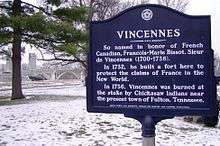François-Marie Bissot, Sieur de Vincennes
François-Marie Bissot, Sieur de Vincennes (17 June 1700 – 25 March 1736) was a French explorer and soldier who established several forts in what is now the U.S. state of Indiana, including Fort Vincennes.
François-Marie Bissot, Sieur de Vincennes | |
|---|---|
 Historical marker in Vincennes, Indiana | |
| Born | 17 June 1700 |
| Died | 25 March 1736 (aged 35) |
| Parent(s) | Jean Baptiste Bissot, Sieur de Vincennes Marguerite Forestier |
François-Marie Bissot was born in Montreal to Jean Baptiste Bissot, Sieur de Vincennes and Marguerite Forestier on June 17, 1700. He was named François Margane after his godfather and uncle.[1] In 1717, he joined his father at Kekionga, a village of the Miami People near present-day Fort Wayne, Indiana in northeastern Indiana. His father was in charge of promoting loyalty to the French among the Miami Indians. By 1718 Vincennes was working among the Ouiatenon Miamis on the upper Ouabache River. When his father died in 1719, François seemed to be the natural replacement.
In May 1722, Vincennes was commissioned an Ensign and took control of Fort Ouiatenon near present-day Lafayette, Indiana.[2] He was promoted to the rank of Lieutenant in 1730 and was made commandant in what is now southern Indiana. The area became increasingly important to New France in keeping their connection to Louisiana open and keeping British traders out. Vincennes was central to this endeavour and also became increasingly attached to the Louisiana contingent. He was commissioned to build a trading post on the Wabash River and established Fort Vincennes where the modern city of Vincennes, Indiana is located. Although the colonial government of Louisiana did not support him, Vincennes convinced local Piankeshaw to establish a village at the post.
In 1733, he married the daughter of Philippe Longpré of Kaskaskia. They had two daughters, Marie Therese and Catherine, the first children of his new village.[3]
On 25 March 1736, François-Marie Bissot de Vincennes was burned by the Chickasaw Indians along with other captive French at the village of Ogoula Tchetoka, near the present site of Fulton, Mississippi,[4][5] though the historical marker in Vincennes (pictured in this article) gives the location as Fulton, Tennessee. They were captured as the result of ill-advised raids in coordination with Pierre D'Artaguiette. The raids are now known as the Chickasaw Campaign of 1736 of the Chickasaw Wars.[6]
References
Notes
- "François Marie Bissot, sieur de Vincennes". The Free Dictionary. Retrieved 2006-05-17.
- Cayton 1996, p. 5.
- Derleth 1968, p. 9.
- Zoltvany 2000.
- Roy 1923, p. 18.
- Roy 1923, pp. 17–18.
Citations
- Cayton, Andrew R. L. (1996). Frontier Indiana. Bloomington, Indiana: Indiana University Press.
- Derleth, August (1968). Vincennes: Portal to The West. Englewood Cliffs, New Jersey: Prentice-Hall. LCCN 68020537.
- Roy, Pierre-Georges (1923). "Sieur de Vincennes Identified". Indiana Historical Society Publications. VII. Indianapolis: C. E. Pauley and Company.
- Bélanger, Claude (2005). "Quebec History". Marianopolis College. Retrieved 2012-05-29.
- Zoltvany, Yves F. (2000). "BISSOT DE VINSENNE (Vincennes), FRANÇOIS-MARIE". Dictionary of Canadian Biography Online. Retrieved 2012-05-29.